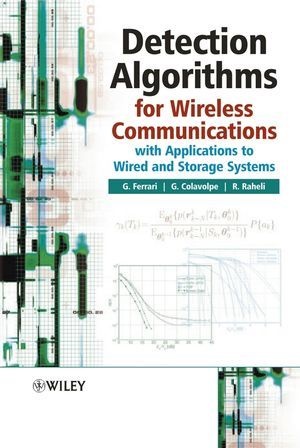Share
Fr. 220.00
Giulio Colavolpe, Colavolpe Giulio, G Ferrari, Gianluigi Ferrari, Gianluigi (University of Parma Ferrari, Gianluigi Colavolpe Ferrari...
Detection Algorithms for Wireless Communications - With Applications to Wired and Storage Systems
English · Hardback
Shipping usually within 1 to 3 weeks (not available at short notice)
Description
Informationen zum Autor Gianluigi Ferrari is an electrical engineer, consultant, and communications educator in Parma, Italy. Giulio Colavolpe is the author of Detection Algorithms for Wireless Communications: With Applications to Wired and Storage Systems , published by Wiley. Riccardo Raheli is the author of Detection Algorithms for Wireless Communications: With Applications to Wired and Storage Systems , published by Wiley. Klappentext Wireless channels are becoming more and more important, with the future development of wireless ad-hoc networks and the integration of mobile and satellite communications. To this end, algorithmic detection aspects (involved in the physical layer) will become fundamental in the design of a communication system.This book proposes a unified approach to detection for stochastic channels, with particular attention to wireless channels. The core idea is to show that the three main criteria of sequence detection, symbol detection and graph-based detection, can all be described within a general framework. This implies that a detection algorithm based on one criterion can be extended to the other criteria in a systematic manner.* Presents a detailed analysis of statistical signal detection for digital signals transmitted over wireless communications* Provides a unifying framework for different signal detection algorithms, such as sequence detection, symbol detection and graph-based detection, important for the design of modern digital receivers operating over mobile channels* Features the hot topic of graph-based detectionDetection Algorithms for Wireless Communications represents a novel contribution with respect to the current literature, with a unique focus on detection algorithms, as such it will prove invaluable to researchers working in academia and industry and in the field of wireless communications, as well as postgraduate students attending advanced courses on mobile communications. Zusammenfassung Presents a unified approach to detection for stochastic channels, with particular attention to wireless channels. This book illustrates how the three main criteria of sequence detection, symbol detection, and graph based detection, can all be described within a general framework. Inhaltsverzeichnis Preface. Acknowledgements. List of Figures. List of Tables. 1. Wireless Communication Systems. 1.1 Introduction. 1.2 Overview of Wireless Communication Systems. 1.3 Wireless Channel Models. 1.4 Demodulation, Detection, and Parameter Estimation. 1.5 Information Theoretic Limits. 1.6 Coding and Modulation. 1.7 Approaching Shannon Limits: Turbo Codes and Low Density Parity Check Codes. 1.8 Space-Time Coding. 1.9 Summary. 1.10 Problems. 2. A General Approach to Statistical Detection for Channels with Memory. 2.1 Introduction. 2.2 Statistical Detection Theory. 2.3 Transmission Systems with Memory. 2.4 Overview of Detection Algorithms for Stochastic Channels. 2.5 Summary. 2.6 Problems. 3. Sequence Detection: Algorithms and Applications. 3.1 Introduction. 3.2 MAP Sequence Detection Principle. 3.3 Viterbi Algorithm. 3.4 Soft-output Viterbi Algorithm. 3.5 Finite-Memory Sequence Detection. 3.6 Estimation-Detection Decomposition. 3.7 Data-Aided Parameter Estimation. 3.8 Joint Detection and Estimation. 3.9 Per-Survivor Processing. 3.9.1 Phase-Uncertain Channel. 3.10 Complexity Reduction Techniques for VA-based Detection Algorithms. 3.11 Applications to Wireless Communications. 3.12 Summary. 3.13 Problems. 4. Symbol Detection: Algorithms and Applications. 4.1 Introduction. 4.2 MAP Symbol Detection Principle. 4.3 Forward-Backward Algorithm. <...
List of contents
Preface.
Acknowledgements.
List of Figures.
List of Tables.
1. Wireless Communication Systems.
1.1 Introduction.
1.2 Overview of Wireless Communication Systems.
1.3 Wireless Channel Models.
1.4 Demodulation, Detection, and Parameter Estimation.
1.5 Information Theoretic Limits.
1.6 Coding and Modulation.
1.7 Approaching Shannon Limits: Turbo Codes and Low Density Parity Check Codes.
1.8 Space-Time Coding.
1.9 Summary.
1.10 Problems.
2. A General Approach to Statistical Detection for Channels with Memory.
2.1 Introduction.
2.2 Statistical Detection Theory.
2.3 Transmission Systems with Memory.
2.4 Overview of Detection Algorithms for Stochastic Channels.
2.5 Summary.
2.6 Problems.
3. Sequence Detection: Algorithms and Applications.
3.1 Introduction.
3.2 MAP Sequence Detection Principle.
3.3 Viterbi Algorithm.
3.4 Soft-output Viterbi Algorithm.
3.5 Finite-Memory Sequence Detection.
3.6 Estimation-Detection Decomposition.
3.7 Data-Aided Parameter Estimation.
3.8 Joint Detection and Estimation.
3.9 Per-Survivor Processing.
3.9.1 Phase-Uncertain Channel.
3.10 Complexity Reduction Techniques for VA-based Detection Algorithms.
3.11 Applications to Wireless Communications.
3.12 Summary.
3.13 Problems.
4. Symbol Detection: Algorithms and Applications.
4.1 Introduction.
4.2 MAP Symbol Detection Principle.
4.3 Forward-Backward Algorithm.
4.4 Iterative Decoding and Detection.
4.5 Extrinsic Information in Iterative Decoding: a Unified View.
4.6 Finite-Memory Symbol Detection.
4.7 An Alternative Approach to Finite-Memory Symbol Detection.
4.8 State Reduction Techniques for Forward-Backward Algorithms.
4.9 Applications to Wireless Communications.
4.10 Summary.
4.11 Problems.
5. Graph-Based Detection: Algorithms and Applications.
5.1 Introduction.
5.2 Factor Graphs and the Sum-Product Algorithm.
5.3 Finite-Memory Graph-Based Detection.
5.4 Complexity Reduction for Graph-Based Detection Algorithms.
5.5 Strictly Finite Memory: Inter-Symbol Interference Channels.
5.6 Applications to Wireless Communications
5.7 An Alternative Approach to Graph-Based Detection in the Presence of Strong Phase Noise.
5.8 Summary.
5.9 Problems.
Appendix: Discretization by Sampling.
A.1 Introduction.
A.2 Continuous-Time Signal Model.
A.3 Discrete-Time Signal Model.
References.
List of Acronyms.
Index.
Product details
| Authors | Giulio Colavolpe, Colavolpe Giulio, G Ferrari, Gianluigi Ferrari, Gianluigi (University of Parma Ferrari, Gianluigi Colavolpe Ferrari, Ferrari Gianluigi, Riccardo Raheli, Raheli Riccardo |
| Publisher | Wiley, John and Sons Ltd |
| Languages | English |
| Product format | Hardback |
| Released | 27.08.2004 |
| EAN | 9780470858288 |
| ISBN | 978-0-470-85828-8 |
| No. of pages | 416 |
| Subjects |
Natural sciences, medicine, IT, technology
> Technology
> Electronics, electrical engineering, communications engineering
Signalverarbeitung, kommunikationstechnik, drahtlose kommunikation, Signal Processing, Mobile & Wireless Communications, Electrical & Electronics Engineering, Elektrotechnik u. Elektronik, Communication Technology |
Customer reviews
No reviews have been written for this item yet. Write the first review and be helpful to other users when they decide on a purchase.
Write a review
Thumbs up or thumbs down? Write your own review.

